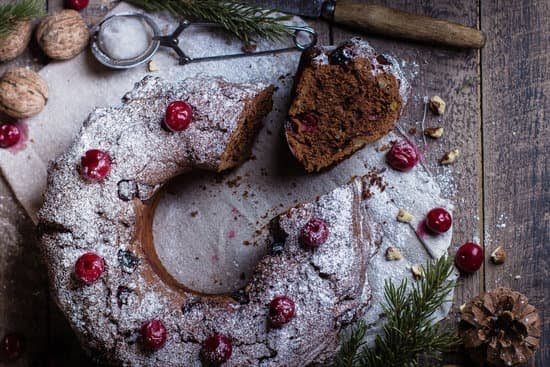Decorated cakes are a delightful and often intricate treat that require proper care to maintain their freshness and appeal. One common question that arises is, how long can a decorated cake stay in the fridge before it goes bad?
Properly storing a decorated cake is crucial to ensuring its longevity and safety for consumption. In this article, we will explore the factors that determine the shelf life of a decorated cake, recommended storage times for different types of decorations, and tips for safely storing and freezing these delectable creations.
Improper storage of a decorated cake in the fridge can lead to potential consequences such as spoilage, loss of flavor, or even foodborne illness. The ingredients used in the cake and frosting, as well as the type of decorations such as fondant or fresh fruit, all play a significant role in determining how long the cake can be stored in the fridge. Additionally, temperature and climate within the fridge also impact the shelf life of a decorated cake.
Understanding these factors will help you gauge the recommended shelf life for different types of decorated cakes. Whether it’s a buttercream-frosted cake or fondant-covered masterpiece, knowing how long they can stay in the fridge is essential for maintaining their freshness. Additionally, being able to recognize signs that indicate your decorated cake has gone bad is important for ensuring its safety for consumption.
Factors That Determine the Shelf Life of a Decorated Cake
When it comes to determining the shelf life of a decorated cake in the fridge, there are several factors that come into play. The type of ingredients used in the cake and frosting, as well as the type of decorations on the cake, can all impact how long the cake will stay fresh. Additionally, the climate and temperature of the fridge itself can also affect the shelf life of a decorated cake.
The ingredients used in both the cake and frosting can greatly influence how long a decorated cake can stay in the fridge. For example, cakes made with dairy or cream-based frostings may have a shorter shelf life compared to cakes with non-dairy or buttercream frostings.
The amount of sugar in the frosting can also play a role, as sugar acts as a preservative. Similarly, if fresh fruit is used as decoration, it can shorten the shelf life due to its perishable nature.
The type of decorations on the cake is another important factor to consider. Cakes covered in fondant may have a longer shelf life compared to those with whipped cream decorations, which tend to soften and lose their shape more quickly when refrigerated. The moisture content of certain decorations can also impact how well they hold up in the fridge.
Recommended Shelf Life for Different Types of Decorated Cakes
Decorated cakes are a delicious and impressive treat for any special occasion. However, to ensure their freshness and safety, it’s important to store them properly in the fridge. But how long can a decorated cake stay in the fridge before it goes bad? The answer depends on several factors, including the type of frosting, decorations, and overall storage conditions.
For buttercream-frosted cakes, they can typically last in the fridge for 3-4 days. The butter in the frosting helps to preserve the cake, but it’s best to consume it within this time frame for optimal taste and texture. On the other hand, fondant-covered cakes have a longer shelf life in the fridge, usually lasting up to 7 days. The fondant acts as a protective covering, keeping the cake moist and fresh for a longer period.
The type of decoration on the cake also plays a role in its shelf life. Cakes with fresh fruit should be consumed within 2-3 days due to the perishable nature of the fruit. Meanwhile, cakes with non-perishable decorations such as chocolate or sugar flowers can last as long as the frosting allows.
It’s crucial to note that these recommended shelf lives are general guidelines and may vary based on individual recipes and storage conditions. It’s always best to use your judgment and consider factors like temperature and visual appearance when determining if a decorated cake is still safe to eat.
| Type of Cake | Shelf Life in Fridge |
|---|---|
| Buttercream-frosted | 3-4 days |
| Fondant-covered | Up to 7 days |
| Fruit-decorated | 2-3 days |
Tips for Properly Storing a Decorated Cake in the Fridge
Properly storing a decorated cake in the fridge is essential to maintain its freshness and prevent it from spoiling. Whether you’ve made the cake yourself or purchased it from a bakery, taking the necessary steps to store it correctly will ensure that it stays delicious for as long as possible. In this section, we will explore some tips for properly storing a decorated cake in the fridge to maximize its shelf life.
The Best Way to Wrap the Cake for Storage
One of the key factors in preserving the freshness of a decorated cake in the fridge is how it is wrapped. After allowing any frosting or decorations to set, carefully cover the entire cake with plastic wrap or aluminum foil. It’s important to ensure that there are no exposed areas where air can reach the cake, as this can lead to drying out and staleness.
To provide an extra layer of protection, place the wrapped cake in an airtight container before putting it in the fridge. This will further prevent any odors or moisture from affecting the taste and texture of the cake. Additionally, if you anticipate needing to store the cake for an extended period, consider using a vacuum sealer to remove all air before sealing.
Preventing Odor Absorption
When storing a decorated cake in the fridge, it’s crucial to prevent it from absorbing any strong odors that may be present. To avoid this, keep the cake away from foods with potent smells such as onions, garlic, or pungent cheeses. If possible, designate a specific area of the fridge just for storing cakes and other baked goods to minimize exposure to other odors.
Another helpful tip is placing a small bowl of baking soda near the cake inside the fridge. Baking soda helps absorb and neutralize odors, thus protecting your decorated cake from taking on any unwanted flavors while being stored.
Other Methods for Prolonging Shelf Life
In addition to wrapping and protecting your decorated cake from odors in the fridge, there are other methods you can use to prolong its shelf life. For example, if your frosted or fondant-covered cake has been cut into pieces but you want to save some for later consumption, cover each individual slice tightly with plastic wrap before refrigerating them separately.
Furthermore, if your climate tends toward high humidity levels, consider using desiccant packets inside the storage container alongside your decorated cake. These packets help absorb excess moisture and can aid in preventing mold growth while extending shelf life.
Signs That a Decorated Cake Has Gone Bad
When storing a decorated cake in the fridge, it is essential to be aware of the signs that indicate the cake has gone bad. While properly stored cakes can last for a certain period, it is important to recognize when it is no longer safe to eat. Here are some signs to look out for:
- Mold: One of the most obvious signs that a cake has spoiled is the presence of mold. If you see any green or black spots on the cake, it’s time to discard it immediately.
- Unpleasant Smell: A fresh cake should have a pleasant aroma. If you notice any unusual or sour odors coming from the cake, it may be an indication that it has gone bad.
- Texture Changes: Pay attention to any changes in the texture of the cake. If it becomes excessively dry, sticky, or slimy, it could be a sign of spoilage.
If you notice any of these signs, it is best to err on the side of caution and refrain from consuming the cake. It’s important to prioritize food safety and avoid consuming anything that may pose health risks.
Additionally, if your decorated cake has been in the fridge for an extended period and you are unsure about its freshness, consider conducting a simple taste test before serving it to your guests. Trust your senses and remember that when in doubt, it’s better to be safe than sorry.
How to Safely Freeze a Decorated Cake for Extended Shelf Life
Freezing a decorated cake is a great way to extend its shelf life, especially if you want to prepare it in advance for a special occasion. Properly freezing a cake can keep it fresh and delicious for weeks or even months. Here are some tips for safely freezing a decorated cake for extended shelf life:
- Choose the right container: When freezing a decorated cake, it’s important to use the right container to prevent damage to the decorations. Opt for a sturdy, airtight container that provides enough room for the cake and its decorations.
- Wrap the cake properly: Before placing the cake in the freezer, make sure to wrap it tightly with plastic wrap or aluminum foil to prevent freezer burn and preserve its moisture. This will help maintain the texture and flavor of the cake when it’s eventually thawed.
- Label and date the container: To keep track of how long the cake has been in the freezer, be sure to label the container with the type of cake and the date it was frozen. This will help you determine when it’s time to thaw and consume the cake.
Thawing a frozen decorated cake properly is just as important as freezing it correctly. Here are some tips for thawing and serving a previously frozen cake:
- Plan ahead: Thawing a frozen decorated cake takes time, so plan ahead and allow enough time for it to defrost properly. Depending on its size, a cake may need several hours or even overnight to thaw completely in the fridge.
- Avoid condensation: To prevent moisture from damaging the decorations on your thawed cake, keep it wrapped while thawing in the fridge. Allowing condensation to form on your decorations can cause them to become soggy or discolored.
- Serve at room temperature: Once fully thawed, allow your decorated cake to come to room temperature before serving. This will ensure that all components of the cake (including frosting and decorations) have reached their optimal texture and flavor.
By following these guidelines for safely freezing and thawing a decorated cake, you can enjoy its fresh taste and beautiful presentation long after it’s been made.
Common Mistakes to Avoid When Storing a Decorated Cake in the Fridge
When it comes to storing a decorated cake in the fridge, there are several common mistakes that people often make. These mistakes can drastically reduce the shelf life of the cake and may even lead to spoilage. It’s important to be aware of these common pitfalls and take steps to avoid them in order to keep your decorated cake fresh and safe for as long as possible.
Failure to Properly Wrap the Cake
One of the most common mistakes when storing a decorated cake in the fridge is failing to wrap it properly. Without adequate wrapping, the cake can quickly dry out and become stale. It’s important to use plastic wrap or airtight containers to seal the cake and prevent exposure to air.
Placing the Cake in an Overcrowded Fridge
Another mistake that many people make is overcrowding their fridge, which can lead to temperature fluctuations and uneven cooling. This can have a negative impact on the freshness of the cake. It’s important to make sure there is enough space around the cake in the fridge for proper air circulation.
Storing the Cake Near Strong-Smelling Foods
It’s crucial to be mindful of what other foods are stored near the decorated cake in the fridge. Strong-smelling foods can easily transfer their odors to the cake, affecting its taste and quality. To prevent this, store the cake away from pungent foods such as onions, garlic, or strong cheeses.
By being mindful of these common mistakes and taking proactive steps to avoid them, you can ensure that your decorated cake stays fresh and delicious for as long as possible in the fridge.
Conclusion
In conclusion, it is essential to prioritize the proper storage of decorated cakes in the fridge to ensure their freshness and safety. The shelf life of a decorated cake can be significantly affected by various factors, including the ingredients used, type of decorations, and the climate within the fridge. Understanding how long different types of decorated cakes can stay in the fridge, as well as the signs that indicate spoilage, is crucial for maintaining the quality of the cake.
By following the recommended shelf life for different types of decorated cakes and implementing proper storage techniques, such as wrapping the cake correctly and preventing absorption of fridge odors, you can prolong the freshness of your cake. It’s also important to pay attention to common mistakes to avoid when storing a decorated cake in the fridge in order to prevent potential pitfalls that can shorten its shelf life.
Ultimately, ensuring the freshness and safety of your decorated cakes relies on being informed about proper storage practices and taking proactive steps to maintain their quality. By following the tips and guidelines outlined in this article, readers can confidently store their decorated cakes in the fridge while preserving their taste and appearance for longer periods.

Welcome to our cake decorating blog! My name is Destiny Flores, and I am the proud owner of a cake decorating business named Cake Karma. Our mission is to provide delicious, beautiful cakes for all occasions. We specialize in creating custom cakes that are tailored specifically to each customer’s individual needs and tastes.





